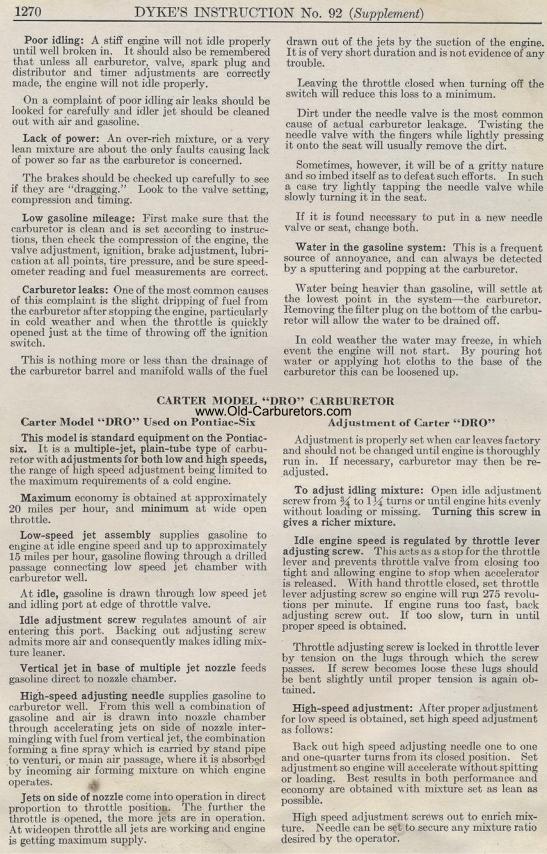Carter
Poor idling: A stiff engine will not idle properly until well broken
in. It should also be remembered that unless all carburetor,
valve, spark plug and distributor and timer adjustments are correctly
made, the engine will not idle properly.
On a complaint of poor idling air leaks should be looked for carefully
and idler jet should be cleaned out with air and gasoline.
Lack of power: An over-rich mixture, or a very lean mixture are
about the only faults causing lack of power so far as the carburetor
is concerned.
The brakes should be checked up carefully to see if they are "dragging." Look
to the valve setting, compression and timing.
Low gasoline mileage: First make sure that the carburetor is clean
and is set according to instructions, then check the compression
of the engine, the valve adjustment, ignition, brake adjustment,
lubrication at all points, tire pressure, and be sure speedometer
reading and fuel measurements are correct.
Carburetor leaks: One of the most common causes of this complaint
is the slight dripping of fuel from the carburetor after stopping
the engine, particularly in cold weather and when the throttle
is quickly opened just at the time of throwing off the ignition
switch.
This is nothing more or less than the drainage of the carburetor
barrel and manifold walls of the fueldrawn out of the jets by the
suction of the engine. It is of very short duration and is not
evidence of any trouble.
Leaving the throttle closed when turning off the switch will reduce
this loss to a minimum.
Dirt under the needle valve is the most common cause of actual
carburetor leakage. Twisting the needle valve with the fingers
while lightly pressing it onto the seat will usually remove the
dirt.
Sometimes, however, it will be of a gritty nature and so imbed
itself as to defeat such efforts. In such a case try lightly tapping
the needle valve while slowly turning it in the seat.
If it is found necessary to put in a new needle valve or seat,
change both.
Water in the gasoline system: This is a frequent source of annoyance,
and can always be detected by a sputtering and popping at the carburetor.
Water being heavier than gasoline, will settle at the lowest point
in the system—the carburetor. Removing the filter plug on
the bottom of the carburetor will allow the water to be drained
off.
In cold weather the water may freeze, in which event the engine
will not start. By pouring hot water or applying hot cloths to
the base of the carburetor this can be loosened up.
CARTER MODEL "DRO" CARBURETOR
Carter Model "DRO" Used on Pontiac Six
This model is standard equipment on the Pontiac
six. It is a multiple-jet,
plain-tube type of carburetor with adjustments for both low and
high speeds, the range of high speed adjustment being limited to
the maximum requirements of a cold engine.
Maximum economy is obtained at approximately 20 miles per hour,
and minimum at wide open throttle.
Low-speed jet assembly supplies gasoline to engine at idle engine
speed and up to approximately 15 miles per hour, gasoline flowing
through a drilled passage connecting low speed jet chamber with
carburetor well.
At idle, gasoline is drawn through low speed jet and idling port
at edge of throttle valve.
Idle adjustment screw regulates amount of air entering this port.
Backing out adjusting screw admits more air and consequently makes
idling mixture leaner.
Vertical jet in base of multiple jet nozzle feeds gasoline direct
to nozzle chamber.
High-speed adjusting needle supplies gasoline to carburetor well.
From this well a combination of gasoline and air is drawn into
nozzle chamber through accelerating jets on side of nozzle inter-mingling
with fuel from vertical jet, the combination forming a fine spray
which is carried by stand pipe to venturi, or main air passage,
where it is absorbed by incoming air forming mixture on which engine
operates. A
Jets on side of nozzle come into operation in direct proportion
to throttle position. The further the throttle is opened, the more
jets are in operation. At wideopen throttle all jets are working
and engine is getting maximum supply.
Adjustment of Carter "DRO"
Adjustment is properly set when car leaves factory and should not
be changed until engine is thoroughly run in. If necessary, carburetor
may then be re-adjusted.
To adjust idling mixture: Open idle adjustment screw from % to
1% turns or until engine hits evenly without loading or missing.
Turning this screw in gives a richer mixture.
Idle engine speed is regulated by throttle lever adjusting screw.
This acts as a stop for the throttle lever and prevents throttle
valve from closing too tight and allowing engine to stop when accelerator
is released. With hand throttle closed, set throttle lever adjusting
screw so engine will run 275 revolutions per minute. If engine
runs too fast, back adjusting screw out. If too slow, turn in until
proper speed is obtained.
Throttle adjusting screw is locked in throttle lever by tension
on the lugs through which the screw passes. If screw becomes loose
these lugs should be bent slightly until proper tension is again
obtained.
High-speed adjustment: After proper adjustment for low speed is
obtained, set high speed adjustment as follows:
Back out high speed adjusting needle one to one and one-quarter
turns from its closed position. Set adjustment so engine will accelerate
without spitting or loading. Best results in both performance and
economy are obtained w ith mixture set as lean as possible.
High speed adjustment screws out to enrich mixture. Needle can
be set to secure any mixture ratio desired by the operator.
Previous page 1927
Supplement Home Next page 
|
